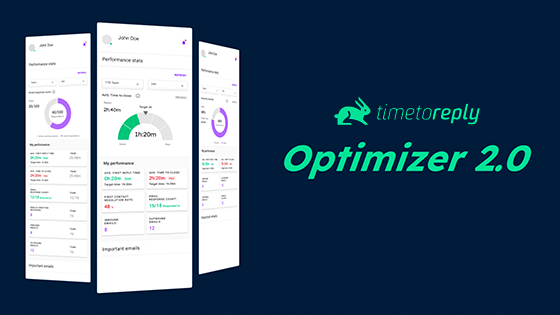It’s time to settle the score on whether a shared or individual mailbox is the king of email management.
Navigating the email landscape in a digital age presents a pivotal choice: shared inbox vs. individual inbox? 🤷♀️
Each has its advantages and challenges, impacting everything from collaboration to organization. 👍👎
A shared inbox emerges as a game-changer in the quest for enhanced team productivity. It is collaborative and efficient and fosters seamless communication.
With shared email access, teams can effortlessly collaborate, delegate tasks, and maintain a unified front in customer interactions.
When it comes to shared inboxes, Gmail offers a user-friendly platform that empowers teams to collaborate.
1️⃣ Real-time collaboration: Gmail shared inboxes enable real-time collaboration, allowing team members to work on emails concurrently.
2️⃣ Enhanced visibility: Team members gain instant visibility into incoming emails, ensuring no message goes unnoticed or unaddressed.
3️⃣ Efficient workflow: Gmail’s shared inbox streamlines workflows through labels, filters, and automated rules.
4️⃣ Accountability: With assigned responsibilities and clear tracking, it’s easy to hold team members accountable for their tasks within the shared inbox.
Outlook‘s shared inbox functionality offers another powerful platform for optimizing collaboration within teams, providing unique benefits for teamwork and productivity:
1️⃣ Seamless integration: As part of Microsoft’s suite of productivity tools, it seamlessly integrates with other Microsoft applications.
2️⃣ Access control: Offers flexible access controls, allowing teams to assign specific roles and permissions to users.
3️⃣ Email tracking: Users can track emails within the shared inbox to monitor when messages are opened, ensuring timely follow-ups and enhancing customer engagement.
4️⃣ Mobile accessibility: Team members can access and collaborate within the shared inbox on various devices, ensuring productivity on the go.
To evaluate shared inbox vs. individual inbox let’s have a look at the pros of individual inboxes:
1️⃣ Privacy and control: Users have sole access and control over their inbox, ensuring privacy and security for personal and sensitive emails.
2️⃣ Customization: Individuals can organize their inbox, set personal preferences, and customize email rules and filters according to their needs.
3️⃣ Reduced distraction: Without the constant influx of shared emails, users can focus on their specific tasks without distraction.
4️⃣ Clear accountability: Individual inboxes promote clear ownership of emails and tasks, reducing confusion about who is responsible for what.
5️⃣ Personalization: Users can personalize their email signatures and communication style, fostering a more personal connection with recipients.
While individual inboxes have advantages, they are not the first choice for collaborative team environments where shared inboxes can streamline communication and accountability, plus many more benefits.
Let’s directly compare shared inbox vs. individual inbox to see how they compare in key areas:
🔵 Collaboration vs. Control
Shared Inbox: Promotes collaboration among team members by allowing multiple users to access and manage emails in a single inbox.
Individual Inbox: Suitable for individuals who prioritize personalization and have minimal need for collaboration.
🔵 Visibility vs. Privacy
Shared Inbox: Provides real-time visibility into incoming emails, ensuring transparency and accountability among team members.
Individual Inbox: Offers privacy and control, keeping personal and sensitive emails confidential.
🔵 Accountability vs. Autonomy
Shared Inbox: Facilitates clear task assignments and accountability within the team.
Individual Inbox: Grants autonomy to users but may lead to ambiguity regarding responsibilities.
🔵Training vs. Familiarity
Shared Inbox: May require training to ensure team members can effectively manage a shared inbox.
Individual Inbox: Requires minimal training.
🔵 Collaboration vs. Isolation
Shared Inbox: Fosters collaboration between team members.
Individual Inbox: Offers limited collaboration and information sharing.
Ultimately, the choice between a shared and an individual inbox depends on the organization’s needs, the nature of work, and the balance between collaboration and individual control required for successful email management.
In the ever-evolving world of email management, optimizing your workflow is essential to maintain efficiency and productivity.
Define what you want to achieve with your email workflow, whether improving response times, enhancing collaboration, or maintaining a clutter-free inbox. Setting specific objectives provides direction and purpose to your email management efforts.
Shared inboxes are ideal for teams that require constant collaboration and shared responsibilities, making it easier to manage customer interactions. They work well when workload distribution needs to be even and when efficient communication among team members is crucial.
In contrast, individual inboxes offer complete privacy and autonomy for roles with minimal collaboration needs and predictable workloads.
Use this checklist of email management best practices to achieve success:
1️⃣Set clear goals: Define specific email management objectives, such as improving response times.
2️⃣Implement Automation: Implement automation to streamline email management.
3️⃣Use email templates: Create and utilize email templates to maintain consistency in responses, saving time and ensuring a professional tone.
4️⃣Leverage live analytics and reports: Utilize real-time analytics and reporting tools to gain insights into email performance and response times.
5️⃣Security awareness: Stay vigilant against email security threats.
6️⃣Implement and monitor SLAs: Utilize tracking and reporting mechanisms to monitor individual and team adherence to these SLAs.

Explore how Deel utilized timetoreply to empower their customer team, enabling them to not only meet but exceed response time expectations in this compelling case study.
Deel’s COO, Dan Westgarth, shares this with us, “No changes to workflow, no ticketing system, no additional channels for our customers to use. Everyone is comfortable with email, and through timetoreply we’ve cut our reply time metrics in half.”
Now, that is what we call customer success!

By mastering their inboxes, Swift Momentum has seen a staggering improvement in their reply times, which have improved by 300-400%!

As email is Clear Skies Title Agency’s primary form of communication, they were looking for a tool to help them gauge email response times and conversation patterns for their support agents. Heather Bryant, Director of Marketing & Client Support, expressed her delight in discovering their response time was on point and utilized the email analytics to streamline staff scheduling.
Businesses have various team communication and collaboration tools to bridge the communication gap.
Many businesses use a combination of tools to address various aspects of communication and collaboration.
Some popular team communication options:
1️⃣ Slack: A versatile messaging platform that offers chat, channels, and integrations for seamless team communication.
2️⃣ Microsoft Teams: Part of the Microsoft 365 suite, it combines chat, video conferencing, file sharing, and collaborative workspaces.
3️⃣ Zoom: A video conferencing tool with features like virtual meetings, webinars, and screen sharing, promoting face-to-face interaction.
4️⃣ Trello: A project management tool that aids in organizing tasks, projects, and workflows with a visual approach.
5️⃣ Asana: A task and project management tool that helps teams coordinate and manage work efficiently.
6️⃣ Google Workspace (formerly G Suite): Offers Gmail, Google Drive, Google Meet, and Google Chat for seamless communication and collaboration.
7️⃣ Slack: A versatile messaging platform that offers chat, channels, and integrations for seamless team communication.
8️⃣ Basecamp: A project management and team collaboration tool that provides centralized communication, task management, and file sharing.
9️⃣ Miro: A digital whiteboard platform for visual collaboration and brainstorming.
🔟 Monday.com: A work operating system that centralizes work and project management.
To enhance email efficiency, integrating email management solutions like timetoreply is pivotal. timetoreply’s shared mailbox reporting software seamlessly integrates with shared and individual inboxes, providing real-time insights into email performance, response times, and SLA adherence.
By carefully assessing the pros and cons of shared inbox vs. individual inbox you can make the right decision. The key is to ensure that your email setup serves your team’s communication needs, ultimately driving productivity and success.
Take action today to boost your team’s efficiency with our shared mailbox reporting software.
Start your journey toward improved efficiency by signing up for our 15-day free trial and experiencing a demo of our powerful tools. Don’t miss this opportunity to supercharge your email management!



Trusted by high-performing inbound sales teams and customer-facing teams globally.
Close more deals and delight more customers with the faster, smarter, deeper email analytics and performance optimization software that works straight from your team’s inbox.